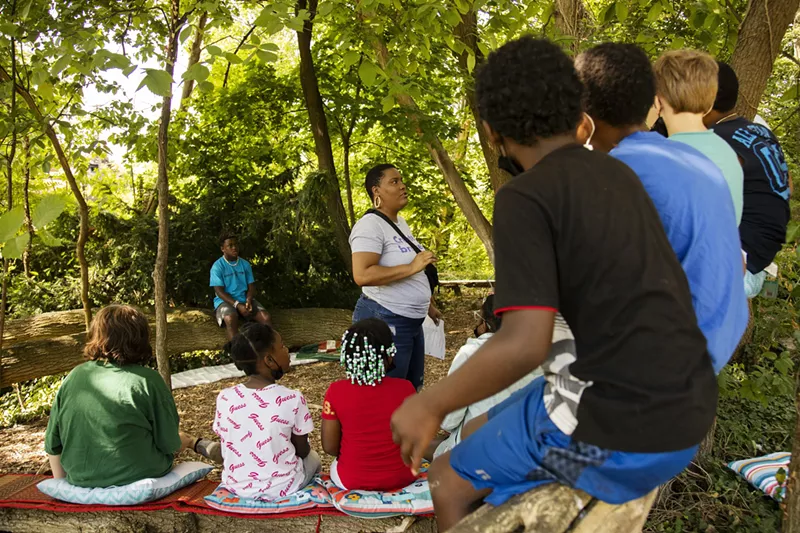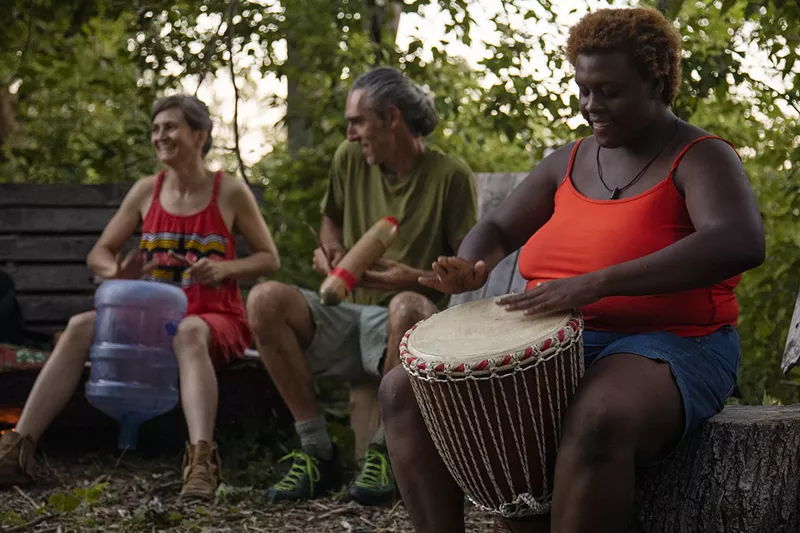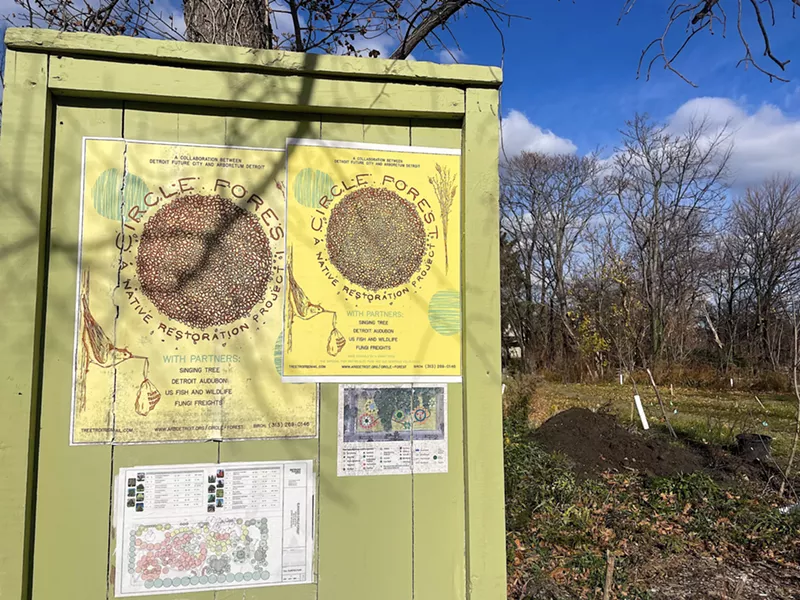Imagine a wild forest full of native trees, birds, and fungi in the middle of Detroit. Imagine not having to venture outside of the city to be immersed in nature, with community gathering space and playscapes for children fashioned from recycled wood.
It’s not far out of the scope of reality. Arboretum Detroit is working to transform 12 vacant lots in the city’s Poletown East neighborhood into an oasis of 200 trees called Circle Forest.
Located at 3301 E. Palmer St., Circle Forest is about the size of a football field. With the help of volunteers, the goal is to cover it in native trees like oak, elderberry, white pine, cedar, juniper, and tupelo. Some invasive species that were already growing on the empty lots are being conserved as well.
The project is a collaboration between Arboretum Detroit and Detroit Future City (DFC) to create more green space in the neighborhood.
“During COVID, it really brought to light the need for places like parks and outdoor spaces with sidewalks so people can easily access those because otherwise, you’re stuck in your house,” says Sarah Hayosh, the land use and sustainability director at DFC.
She adds, “We want to improve the quality of life of the people in these neighborhoods and create access to nature and opportunities for kids to have a place to run free and play.”
Executive director of Arboretum Detroit Andrew Kemp says the city has opportunities to repurpose land for forests, gardens, and outdoor spaces that other cities don’t. Kemp is known locally as “Birch,” a fitting name for a man that spends his free time planting trees.
“Life breeds life, and garbage attracts garbage. When people see the garbage, they’re more apt to just throw more garbage. And when they are in a space like this with life, it attracts more life.”
tweet this
Like many abandoned lots in the city, Circle Forest was a dumping ground before Arboretum bought them from the Detroit Land Bank Authority in 2019. Birch and a host of volunteers filled two dumpsters with discarded roofing, toilets, pools, beds, and other random trash as they cleaned the area.
So far, around 120 trees have been planted in Circle Forest. The space also features a fire ring, a play area made of tree stumps, and a “critter path” fashioned from salvaged wood.
“This became Circle Forest because part of the idea was to plant these trees in family groups to demonstrate how trees work in symbiosis with each other and how the fungal network allows them to communicate and share resources,” Birch says.
It’s been host to jam sessions, a balsam oil-making workshop, herbal medicine classes with Herbalists Without Borders Detroit, and youth poetry sessions in partnership with the Heidelberg Project and InsideOut.
“It was a really great day,” Birch says about the youth poetry workshop. “These kids were hanging from trees while they’re writing poetry and it was really beautiful to see the forest activated in that way. Life breeds life, and garbage attracts garbage. When people see the garbage, they’re more apt to just throw more garbage. And when they are in a space like this with life, it attracts more life.”

Garrett MacLean/ Courtesy photo
Detroit poet Jassmine Parks leads a poetry workshop in Circle Forest.
Circle Forest was made possible via grant funding through the Southeast Michigan Resilience Fund, the National Fish and Wildlife Foundation, and General Motors.
Arboretum Detroit also received a grant from the American Association of Retired Persons that’s being used to build a boardwalk to make the forest wheelchair accessible. The hope is that residents of an adjacent nursing home and rehabilitation center will also be able to enjoy the green space.
“They don’t get out too much, so one of our goals is to encourage them to bring their residents out here in nature because we know that nature increases recovery,” Birch says.
DFC first got involved in 2019 when Arboretum Detroit applied for the nonprofit’s Working with Lots grant to build a tree nursery in the neighborhood. DFC decided to partner with Arboretum Detroit for Circle Forest as they continued to engage with Detroit communities on local land use.
“The goal is to increase dialogue about what lots should be green space and how can we better improve the green spaces that are here already, because there’s a long history of residents that are stewarding the land and living on land, building gardens and community spaces, and we want to be able to support that,” Hayosh says.
While Birch and Hayosh expect Circle Forest to be fully activated with the accessible path and an open deck by next spring, it’s already proven to be a useful community resource.
“Every time I’m up here, I see kids running around, or workers from that facility over here catching a smoke, neighbors over here building a fire and cooking breakfast, it’s amazing,” he says. “It’s here for people and people are finding it.”
Circle Forest will eventually be part of a walkable “green loop” that connects nearby outdoor projects like Fungi Freights, Arboretum Detroit’s tree nursery, a meditation space called Field Temple, and another tree-planting project called Oxygen Alley.

Garrett MacLean/ Courtesy photo
A jam session in Circle Forest. Andrew “Birch” Kemp (center) founded Arboretum Detroit in 2019.
Arboretum Detroit is building Oxygen Alley in honor of the toxic Russell Street incinerator being shut down.
Birch is a native Detroiter who has lived in the neighborhood in the incinerator’s shadow for the past 20 years. He formed Arboretum Detroit as a nonprofit in 2019 in response to the area’s poor air quality.
“I realized in retrospect that I was frantically building this vegetative buffer between me and those smells and chemicals,” he says about his tree-planting work. “The incinerator is gone, but there are other waste industries still over there, so we’re doing this to create more oxygen and filtration. We can’t separate this neighborhood from that experience. It was like every day, you’d go out your door not knowing what you’re gonna get. You could be having a party in your backyard and then suddenly your neighborhood smells like shit.”
Birch remembers being in the DFC office when news broke of the incinerator’s shutdown.
“It was the community that shut it down,” he says. “We had to be calling the Department of Environmental Quality about air quality violations every day for 20 years. When we learned that they shut it down my head was spinning. There had been many attempts, so I just didn’t really have that much faith, but that gave us so much new hope and energy to do all this stuff.”
It’s hard to imagine in our modern society fueled by capitalism, but there was once a time when the landscape of cities like Detroit was dominated by nature. Trees took root in soil that has since been disturbed by houses and paved over with roads.
Circle Forest is a human effort to help nature reclaim itself so that we can find harmony with the flora and fauna again.
Follow us: Google News | NewsBreak | Reddit | Instagram | Facebook | Twitter


